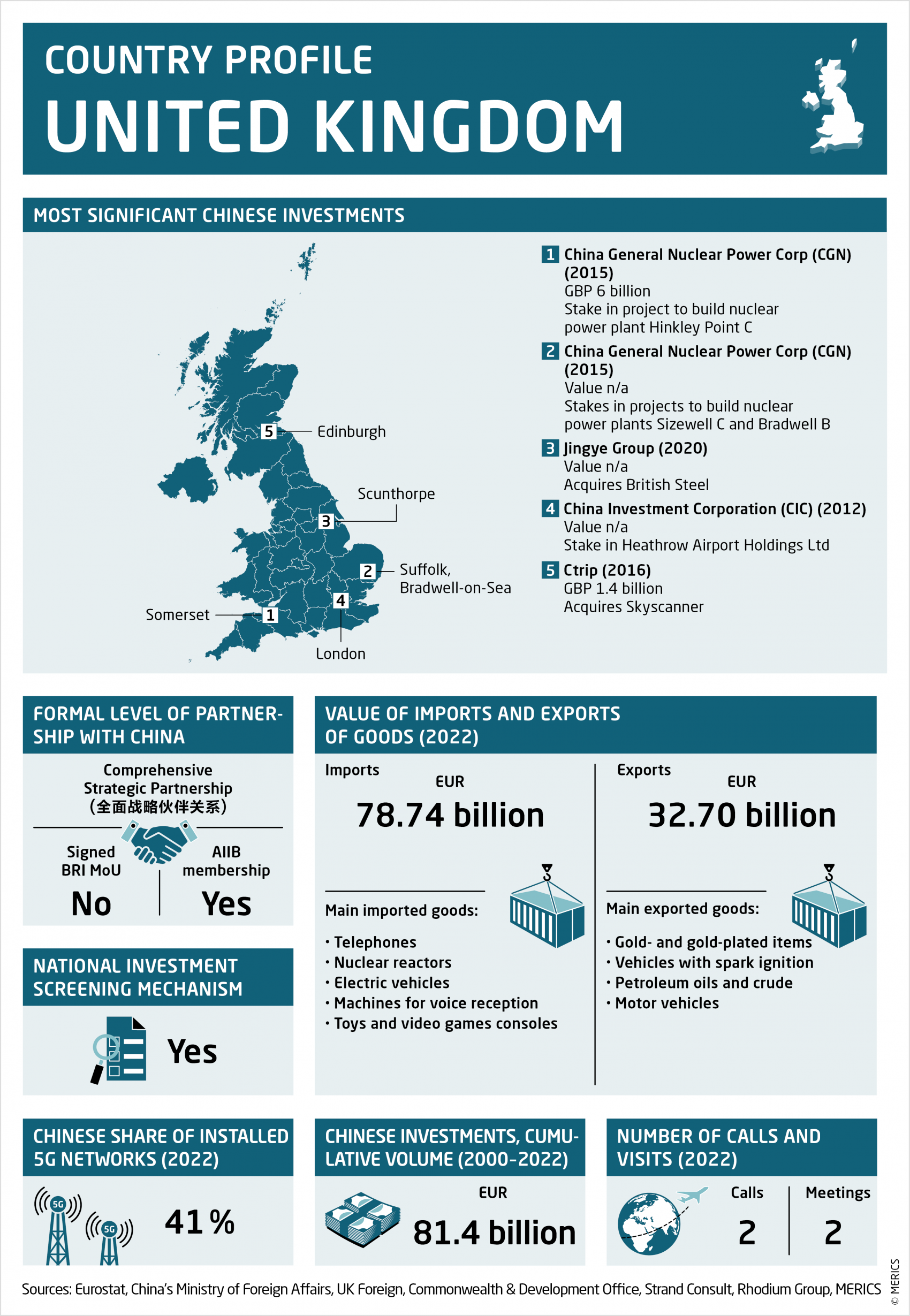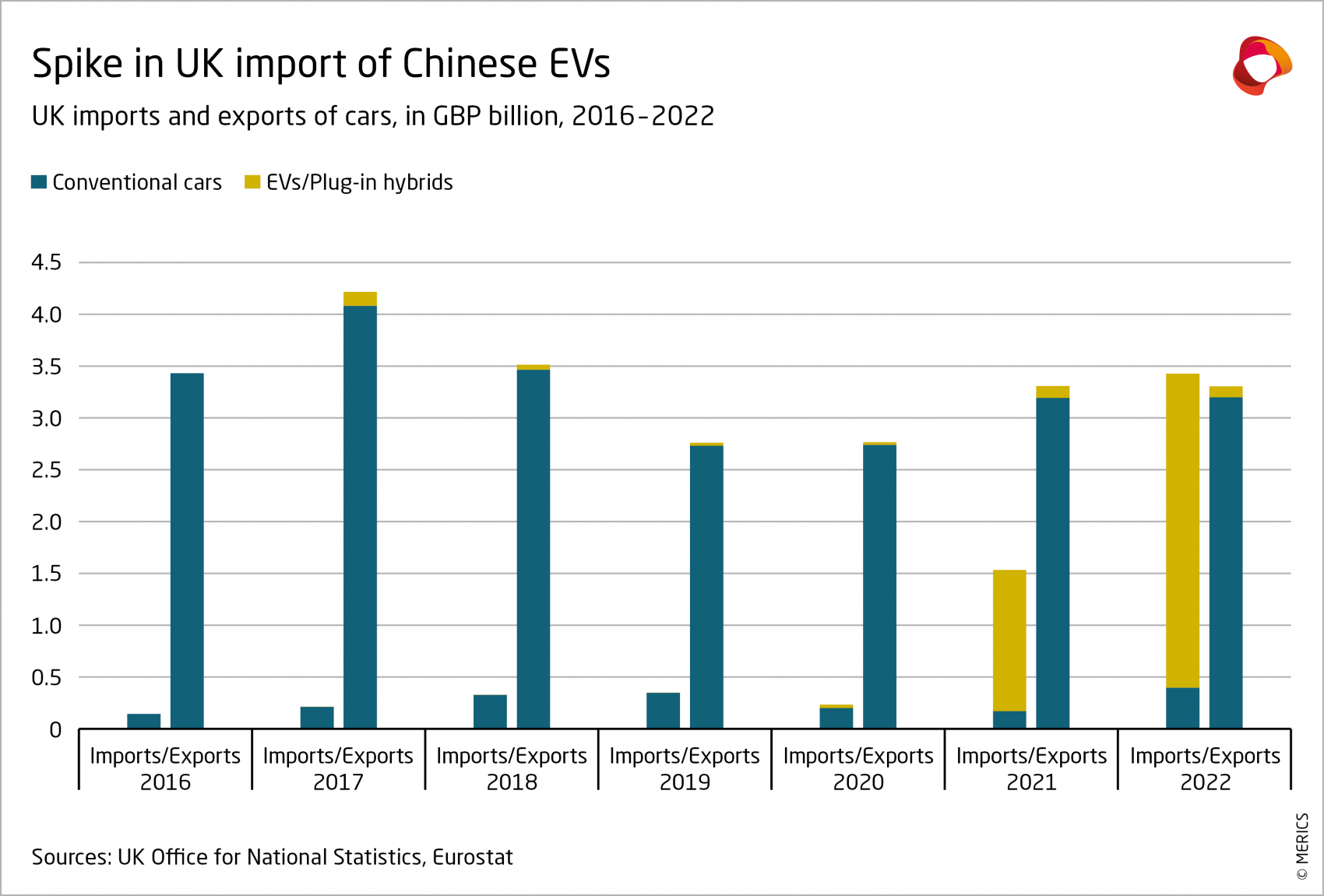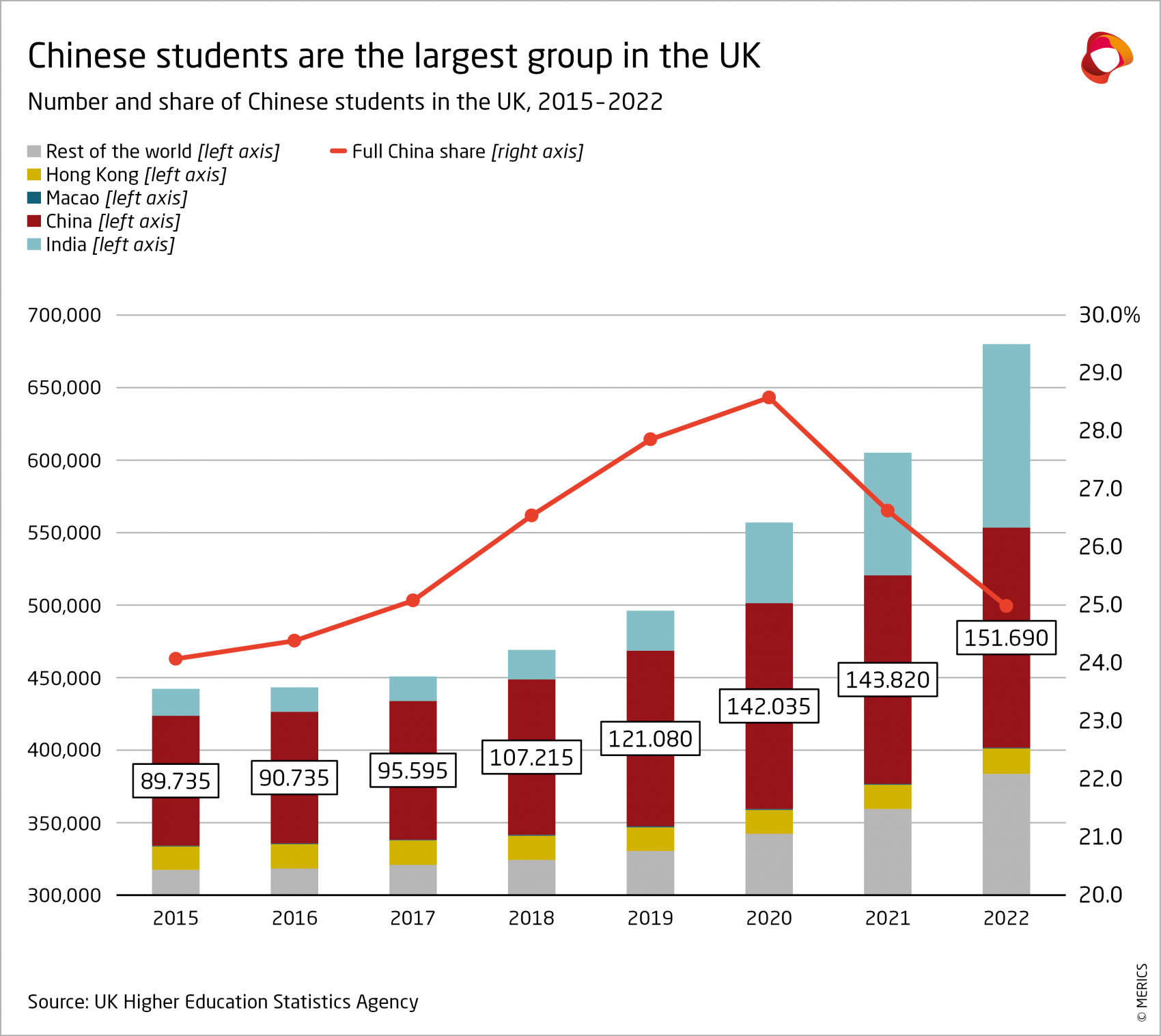

Country Profile: United Kingdom
You are reading the country profile for the United Kingdom. Click here to go back to the country profiles overview page.
1. Introduction
The bilateral relationship between the UK and China has undergone dramatic changes from the Golden Era of the Cameron Premiership to the Integrated Review Refresh, when China became an epoch-defining and systemic challenge for the UK. The shifts have also led the country to increase its China-related capacity-building. Many factors have contributed to such a shift, some are internal and have to do with changes of leadership that brought about different views of and approaches to China and the economic relationship between the UK and China, such as in the case of Chinese acquisitions of British strategic assets. Others are external, the most notable of which is the application of the National Security Law in Hong Kong.
Understandably, Hong Kong features prominently in the UK’s bilateral agenda with agenda, more prominently than in that of other European countries. Despite the changes, there are still strong connections between the two countries and one of the elements at their basis is the remarkably high reliance that UK universities have on the fees paid by Chinese students. Chinese students are the largest group of foreign students in the, at 151,690 in the 2021/2022 academic year.
2. Key Categories
Economy
China is the UK’s main import partner. According to data collected by MERICS, China provided 13 percent of all UK imports in 2021, and slightly less than 10 percent in 2022. But China is only the UK’s sixth export partner, as China-bound exports were 4.4 percent of all exports in 2021 then returned to pre-pandemic levels at 6.6 percent in 2022.
Electric vehicles (EVs) were the third largest item imported from China, while petrol and diesel vehicles featured heavily in UK exports to China. As elsewhere in Europe, imports of Chinese EVs and their components are growing in importance, while European car plants continue to produce vehicles due to be slowly phased out in the coming years.
The UK has historically been amongst the top-three European destinations for Chinese investments, including in pharmaceutical and biotech giant AstraZeneca and, controversially, in nuclear energy. The UK cumulative total Chinese investments are the highest in Europe, amounting to EUR 81.4 billion (compared to Germany with EUR 32 billion; France’s EUR 17 billion: and Italy’s EUR 16 billion).
Although the UK was latecomer to screening foreign direct investment, the National Security and Investment Act (2021), it has already seen its fair share of controversial cases. In the 2022, when Chinese-owned Nexperia sought to buy Newport Wafer Fab, the UK government ordered the Chinese firm to disinvest 86 percent of its shares in the semiconductor wafer producer.
Politics
In 2015, the government of Prime Minister David Cameron inaugurated the Golden Era of UK China relations during a state visit by President Xi Jinping to London. Large infrastructure investments, such as those in the nuclear energy sector emerged at the time. Since 2015, there have been many official visits . The pandemic put a stop to bilateral visits and the August 2023 visit to Beijing by foreign minister James Cleverly was the first since 2019. Attitudes to China have hardened meanwhile and Cameron’s open-door policy has been replaced by greater political caution.
The relationship between China and the UK displays special features and the most notable regards the status of Hong Kong. The fact that before 1997, the UK had a territory de facto in China has created strong linkages, which are now the source of some of the biggest strains. For example, Beijing’s introduction of the National Security Law in Hong Kong spurred the UK government’s decision to introduce the British National Overseas (BNOs) visa to create a safe migration route.
The UK does not have a specific China strategy, but China appears in the Integrated Review of Security, Defence, Development and Foreign Policy (2021) which was itself reviewed in 2023 as the Integrated Review Refresh. The 2021 Integrated Review identified China as a systemic competitor to the UK, but there was still a strong call for openness and collaboration. In the Integrated Review Refresh, China became an epoch-defining and systemic challenge, while still leaving space for collaboration. The official approach of the UK to China is three-fold: protect, align, engage.
Security
The UK has no extradition treaties signed with China. It suspended its one with Hong Kong (1998), in 2020 after Beijing violated the China-UK treaty on Hong Kong’s separate identity, and to protect Hong Kong exiles entering the UK on BNO visas. China is also the sixth largest recipient of arms from the UK. After 1989, the UK observed the European arms embargo on China. However, from 1995, the UK’s interpretation of the embargo only included “lethal weapons such as machine guns, large caliber weapons, bombs, torpedoes, rockets and missiles; specially designed components of the above, and ammunition; military aircraft and helicopters, vessels of war, armored fighting vehicles and other such weapons platforms; any equipment which is likely to be used for internal repression.”
After Beijing imposed the National Security Law in Hong Kong in June 2020, the UK extended the embargo to Hong Kong.
With other members of the Five Eyes intelligence sharing pact, the UK in 2020 introduced a ban on Huawei from its 5G networks, which included removing the existing Huawei presence from 5G public networks by 2027. Huawei’s removal from the “core” of the networks must be concluded by the end of 2023.
Society
The UK has one of the largest Chinese diasporas in Europe. The 2021 census differentiated between recent Chinese immigrants (445,646 people, or roughly 0.7 percent of the population) and British Chinese, of whom there were 124,000. Chinese students were the largest group of foreign students, at 151,690 in the 2021/2022 academic year. UK universities have become increasingly reliant of the higher fees paid by foreign students, and hence on Chinese students as the largest cohort. There have been controversies where Chinese students have criticized curricula and lectures as anti-China or different from the PRC’s main line. In one such episode, a globe displayed outside the London School of Economics in 2019 showed Taiwan as a separate entity from the PRC. After protests from mainland students, the artist added an asterisk next to Taiwan.
Chinese funding of research projects and donations has also emerged as an issue. For example, in 2019, Oxford stopped accepting funds from Huawei, but other research does use Chinese funds. There are debates about Chinese influence in the UK’s research and innovation environment, and how to protect free speech for students.
Public opinion towards China is roughly two thirds unfavorable, at 69 percent to 27 percent in 2022. However, this is better than the 2020 low point (22 percent favorable and 74 percent unfavorable).
You were reading the country profile for the United Kingdom. You can return to the country profiles overview page here.

This MERICS analysis is part of the project “Dealing with a Resurgent China” (DWARC) which has received funding from the European Union’s Horizon Europe research and innovation programme under grant agreement number 101061700.
Views and opinions expressed are however those of the author(s) only and do not necessarily reflect those of the European Union. Neither the European Union nor the granting authority can be held responsible for them.



